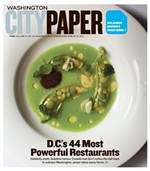A Reporter in Search of a Novel
Of all productive human activities, writing is among the hardest to put on screen. A century of montages of quills squeaking, fingers hammering keyboards, and pages blowing around garrets has yielded only yawns. Reporting, however, is another matter: A reporter is a detective of sorts, and given a sufficiently lurid case, he or she automatically becomes a film-noir character, stalking dark alleys in search of light. This setup works, Capote demonstrates, even if the reporter is a squeaky-voiced gay narcissist who combines the off-putting mannerisms of the Deep South bard with those of the Manhattan intellectual.
Scripted by Dan Futterman, who relied on Gerald Clarke's biography, the film is not the biopic its title suggests. Ignoring the writer's early successes and awkward decline, director Bennett Miller recounts only Capote's seven-year campaign to report and write In Cold Blood, his 1966 "nonfiction novel" and last completed work. (His 18 post-Blood years seem to have been largely devoted to drinking and appearing on talk shows.) A poetic account of a Kansas family's senseless murder, Capote's book was part of a trend toward applying novelistic techniques to journalism. But Capote--unlike Tom Wolfe, Gay Talese, and other stars of the new genre--came from fiction, not daily newspapers, and he never entirely abandoned it. Although he resolutely pursued the story of the killers, when it came time to finish the book, Capote couldn't resist making a few things up.
But that's writing, and the movie doesn't waste much time on that. It follows Capote (Philip Seymour Hoffman) between Kansas and New York, depicted in the customary bleached colors and accompanied by the usual piano dribbles. Initially, he's joined by childhood pal Harper Lee (Catherine Keener), who starts as his "research assistant and personal bodyguard." (Before Capote's project is completed, however, Lee eclipses him by publishing To Kill a Mockingbird.) Capote's assignment to cover the case for the New Yorker doesn't impress impassive local policeman Alvin Dewey (Chris Cooper), but having written Breakfast at Tiffany's gets in him the back door, which is happily opened by the cop's celeb-struck wife. Indefatigable or simply impudent, Capote locates the teenager who found the bodies and pops open a coffin to see how corpses with fatal gunshot wounds to the head are prepared for burial. Once killers Perry Smith (Clifton Collins Jr.) and Dick Hickock (Mark Pellegrino) are arrested, Capote rushes to meet them and then pays them the ultimate New York compliment: He gets Richard Avedon to take their portraits.
Capote, abandoned by his parents as a child, sees something of himself in the similarly injured Smith, and he begins an intense, not exactly disinterested relationship with the killer. Other characters fill in the group shots, including a miscast Bob Balaban as mythic New Yorker editor William Shawn and Bruce Greenwood as Jack Dunphy, Capote's neglected (and, in this movie, kind of boring) lover. Lee surfaces periodically in the role of Capote's conscience, reminding him that he's using the murderers for his own purposes. But most viewers won't need that cue, because the jailhouse conversations between Capote and Smith coolly reveal the exploitation.
This is Bennett Miller's first fiction film, but he did previously direct a documentary, 1998's The Cruise, a portrait of a tour guide who's another New York type: the garrulous autodidact. It's tempting to classify Capote as a sort of sequel to that movie, with Hoffman's eerie impersonation of the title character serving as the next best thing to documentary. Yet the film's most vivid sequences are those with Capote and Smith, not the ones that depict the celebrity writer with admiring New Yorkers, whether he's holding court in bars or reading passages from the then-unpublished book--was Capote's prose really that bad?--to a packed hall.
Hoffman's Capote is a yipping, haughty poodle in a Bergdorf scarf, a far more assertive (if perhaps no more accurate) characterization than the actor's turn as Lester Bangs in Almost Famous. He easily upstages single-note performances by Keener, Cooper, and the other supporting players, except for one: Collins' Smith really does seem to be Capote's other half, more conventionally doomed, but in many ways an equal. Capote seduces him, not physically, but with genuine empathy and probable lust--both trumped by the ambition that recognizes Smith's life story as "a goldmine." When the killers' final appeals are denied, Capote blubbers, "I did everything I could," but his tears are more for himself than them.
Capote became the authority on Smith, whose outlaw persona suited the times. In 1967--when Smith was played by Robert Blake, of all people, in the movie version of In Cold Blood--some might well have seen the part-Indian man's killings as repaying America's crimes with random violence. He's victim as well as victimizer, but Capote adds a new dimension to the former identity. Drawing on the anti-journalism essays of Janet Malcolm, another New Yorker writer, Futterman's script depicts reporting as a con game and Capote as its wiliest huckster. According to this film's stern indictment, the U.S. of A. wounded Perry Smith, but Truman Capote finished him off.

